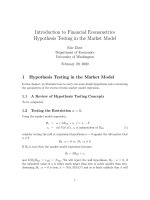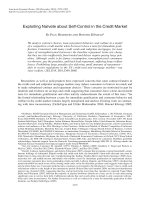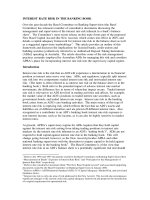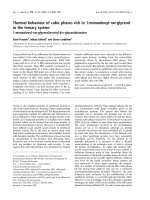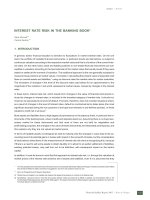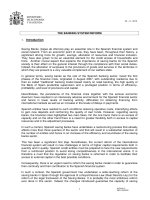Useful book about stress testing in the banking system
Bạn đang xem bản rút gọn của tài liệu. Xem và tải ngay bản đầy đủ của tài liệu tại đây (2.78 MB, 352 trang )
Stress-testing the Banking System
Stress tests are used in risk management by banks in order to determine how certain
crisis scenarios would affect the value of their portfolios, and by public authorities
for financial stability purposes. Until the first half of 2007, interest in stress-testing
was largely restricted to practitioners. Since then, the global financial system has been
hit by deep turbulences, including the fallout from sub-prime mortgage lending.
Many observers have pointed out that the severity of the crisis has been largely due
to its unexpected nature and have claimed that a more extensive use of stress-testing
methodologies would have helped to alleviate the repercussions of the crisis. This book
analyses the theoretical underpinnings, as well as the practical aspects, of applying
such methodologies. Building on the experience gained by the economists of many
national and international financial authorities, it provides an updated toolkit for both
practitioners and academics.
Mario Quagliariello is a senior economist in the Regulation and Supervisory Policies
Department of the Bank of Italy. He has been the representative of the Bank of Italy in
a number of international working groups dealing with financial stability issues and
has published several articles in international and Italian journals. He has a PhD in
economics from the University of York.
Stress-testing
the Banking System
Methodologies and Applications
Edited by
Mario Quagliariello
cambridge university press
Cambridge, New York, Melbourne, Madrid, Cape Town, Singapore, São Paulo, Delhi
Cambridge University Press
The Edinburgh Building, Cambridge CB2 8RU, UK
Published in the United States of America by Cambridge University Press, New York
www.cambridge.org
Information on this title: www.cambridge.org/9780521767309
© Cambridge University Press 2009
This publication is in copyright. Subject to statutory exception
and to the provisions of relevant collective licensing agreements,
no reproduction of any part may take place without
the written permission of Cambridge University Press.
First published 2009
Printed in the United Kingdom at the University Press, Cambridge
A catalogue record for this publication is available from the British Library
Library of Congress Cataloguing in Publication data
Stress-testing the banking system : methodologies and applications / edited by Mario Quagliariello.
p. cm.
ISBN 978-0-521-76730-9
1. Banks and banking. 2. Banks and banking – Risk management. 3. Bank failures – Prevention.
4. Financial crises. I. Quagliariello, Mario. II. Title.
HG1601.S687 2009
332.10680 1–dc22
2009010745
ISBN 978-0-521-76730-9 hardback
Cambridge University Press has no responsibility for
the persistence or accuracy of URLs for external or
third-party Internet websites referred to in this publication,
and does not guarantee that any content on such
websites is, or will remain, accurate or appropriate.
Contents
List of figures
List of tables
List of boxes
List of contributors
Foreword
page x
xii
xiv
xv
Giovanni Carosio (Bank of Italy, Deputy Director General)
Acknowledgements
xxi
xxiii
Introduction
Mario Quagliariello (Bank of Italy)
1
Part I
Fundamentals
5
1
A framework for assessing financial stability
Maurizio Trapanese (Bank of Italy)
1.1
1.2
1.3
1.4
1.5
2
Introduction
Building the framework
The use of macroprudential analysis for assessing financial stability
Looking for instability
Conclusions
References
7
7
9
11
12
16
17
Macroeconomic stress-testing: definitions and main components
Mario Quagliariello (Bank of Italy)
18
2.1
2.2
2.3
2.4
18
19
22
25
35
Introduction
Objectives of stress-testing: the micro and macro perspectives
Stress tests: definitions
The ingredients for macroeconomic stress-testing
References
vi
Contents
3
Macroeconomic stress-testing banks: a survey of methodologies
4
5
6
Mathias Drehmann (Bank for International Settlements)
37
3.1
3.2
3.3
3.4
3.5
3.6
37
38
48
50
55
Introduction
Exposures to risk
The risk measure
The model of the data generating process
Methodological challenges
The new frontier: an integrated approach to macroeconomic
stress-testing
References
60
62
Scenario design and calibration
Takashi Isogai (Bank of Japan)
68
4.1
4.2
4.3
4.4
68
69
74
77
78
Introduction
Objectivity and plausibility of stress tests
Technical discussion on the plausibility of stress scenarios
Conclusions
References
Risk aggregation and economic capital
Vincenzo Tola (Bank of Italy)
80
5.1
5.2
5.3
5.4
5.5
5.6
80
81
83
84
87
96
97
Introduction
Some basic definitions
Related literature
Copulas
Copulas in an economic capital model
Conclusions
References
Data needs for stress-testing
Francesco Cannata (Bank of Italy) and Ulrich Krüger
(Deutsche Bundesbank)
6.1
6.2
6.3
6.4
6.5
Introduction
Overview of the information needed for stress-testing
Data needs by risk type
A focus on credit risk
A possible tool for organising data
References
99
99
100
103
106
110
115
vii
7
Part II
8
9
10
Contents
Use of macro stress tests in policy-making
Patrizia Baudino (Financial Stability Board)
117
7.1 Introduction
7.2 Use of macro stress tests for policy-making: limitations
and benefits
7.3 How macro stress tests have been used for policy-making
References
117
120
124
128
Applications
131
Stress-testing credit risk: the Italian experience
Sebastiano Laviola, Juri Marcucci and Mario Quagliariello (Bank of Italy)
133
8.1
8.2
8.3
8.4
8.5
133
134
135
143
147
148
Introduction
The Italian banking system: some stylised facts
An analytical framework for stress-testing credit risk
Stress test results
Conclusions
References
Stress-testing US banks using economic-value-of-equity
(EVE) models
Mike Carhill (Office of the Comptroller of the Currency)
149
9.1 Introduction
9.2 The EVE concept
9.3 Future business
9.4 Model uncertainty
9.5 Credit risk
9.6 Conclusions
Appendix Variation of deposit sensitivity estimates across banks
References
149
151
153
155
160
162
162
163
A framework for integrating different risks: the interaction
between credit and interest rate risk
Steffen Sorensen (Barrie and Hibbert) and Marco Stringa (Bank of England)
165
10.1 Introduction
10.2 A framework for integrating interest rate and credit risk
165
168
viii
Contents
10.3
10.4
10.5
10.6
11
12
Building blocks of the stress test
Illustrative simulations
Future challenges to capture integration in macro stress tests
Conclusions
References
Stress-testing linkages between banks in the Netherlands
Iman van Lelyveld, Franka Liedorp and Marc Pröpper (De Nederlandsche Bank)
184
11.1
11.2
11.3
11.4
11.5
184
185
187
193
199
201
Introduction
The Dutch financial landscape
Interbank loan market
Payment networks
Conclusions
References
An integrated approach to stress-testing: the Austrian Systemic
Risk Monitor (SRM)
Michael Boss, Gerald Krenn, Claus Puhr and Martin Summer
(Oesterreichische Nationalbank)
12.1
12.2
12.3
12.4
12.5
12.6
12.7
12.8
13
172
175
181
182
182
Introduction
The Austrian banking system
Theoretical foundations of the SRM
Input data of the SRM
Application of the SRM
Output data of the SRM
Some examples of stress tests with the SRM
Conclusions
References
202
202
204
206
214
217
221
224
235
237
From macro to micro: the French experience on credit risk
stress-testing
Muriel Tiesset and Clément Martin (Banque de France – French Banking
Commission)
13.1 Main features and objectives of the French stress-testing
framework
13.2 Stress-testing the French banking sector through
macroeconomic scenarios
13.3 Stress-testing corporate credit portfolios through ad hoc
credit shocks: analysing banks’ concentration risk on
business sectors
238
238
241
251
ix
Contents
13.4 Micro surveillance of French banks’ credit portfolio risk
profile and potential micro/macro links
13.5 Conclusions
Appendix 1 The credit risk migration model
Appendix 2 The model of bank profitability
References
14
15
16
252
255
256
259
260
Stress-testing in the EU new member states
Adam Głogowski (National Bank of Poland)
261
14.1
14.2
14.3
14.4
14.5
14.6
261
263
269
271
273
274
276
Introduction
Credit risk stress-testing
Market risk stress-testing
Liquidity risk stress-testing
Interbank contagion in stress tests
Challenges for the future
References
Cross-border macro stress-testing: progress and future
challenges for the EU
Olli Castrén, John Fell and Nico Valckx (European Central Bank)
278
15.1 Introduction
15.2 Accounting for the cross-border dimension in credit risk
stress-testing
15.3 European challenges to cross-border stress-testing
15.4 Conclusions
References
278
279
287
294
295
Stress-testing at the IMF
Marina Moretti, Stéphanie Stolz and Mark Swinburne (International Monetary Fund)
297
16.1 Introduction
16.2 Background: overview of the FSAP
16.3 Stress-testing in FSAPs
16.4 FSAP stress-testing going forward
Annex Stress-testing in European FSAPs
References
297
299
300
307
310
316
Conclusions
Mario Quagliariello (Bank of Italy)
318
Index
322
Figures
2.1
2.2
2.3
2.4
2.5
3.1
3.2
3.3
5.1
5.2
5.3
8.1
9.1
10.1
10.2
10.3
10.4
10.5
10.6
10.7
11.1
11.2
11.3
11.4
Overview of macroeconomic stress-testing
Approaches to macroeconomic stress tests
Main components of stress-testing procedures
From risk factors to key macroeconomic variables
Impact of different shocks on solvency ratios
Schematic structure of current macro stress-testing models
A graphical representation of Merton’s model
Challenges for stress-testing models
Simulations of bi-variate random vectors from different
distributions
Comparison from different loss density probability functions and
ratio of percentiles (from 80th to 100th) between t3 and meta t3
copulas
Comparison across diversified and undiversified loss density
distributions and across economic capital values
Stress-testing credit risk
An application of EVE models
Evolution of the default-free term structure over the next twelve
quarters in the base and stress scenario respectively
Steps of the stress test
Shareholder funds as a proportion of risk-weighted assets
Impact on write-offs
Impact on net-interest income
Impact on net profits
Capital adequacy with debt, constant spreads and cyclical loss
given default (LGD)
The interbank lending matrix
Cumulative effects of simulated failures
Selected network measures
Impact of node removal on network properties
page 21
23
26
32
34
38
42
55
92
93
95
136
163
176
176
177
178
178
179
181
190
192
197
198
List of figures
xi
11.5
12.1
12.2
12.3
13.1
13.2
13.3
14.1
15.1
15.2
Development of a selection of traditional system measures and
network properties over time
Basic structure of the SRM
Density functions of loss distributions for the aggregated Austrian
banking system according to the baseline simulation over the first
quarter 2008
Bank defaults due to foreign currency loan losses based on
end-2007 data
A snapshot of the French macro stress-testing framework
Net banking income structure
Cumulative impact of the stress scenarios on the dynamics of
banks’ profitability and RWA
An example of a credit risk stress test combining aggregate and
microlevel models. The approach of the National Bank of Poland
Gross cross-border banking flows across selected EU countries
and the US
Banking system regulatory capital ratios after a failure of a national
banking system in the cross-border banking flows network
200
207
226
230
242
245
251
269
285
286
Tables
2.1
5.1
5.2
8.1
8.2
8.3
8.4
8.5
9.1
10.1
11.1
12.1
12.2
12.3
13.1
13.2
13.3
13.4
13.5
14.1
14.2
15.1
15.2
Some examples of historical scenarios and crisis triggers
Descriptive statistics of some risk measures computed in the
Monte Carlo simulation
Comparison among undiversified and diversified economic
capitals at the 99.96 per cent level of confidence
Macroeconomic stress-testing scenarios
Stress test results
Top-down vs. bottom-up definitions
Sensitivity analysis: comparison of top-down and bottom-up
results
Sensitivity analysis: comparison of top-down and bottom-up
banks’ ranking
An application of EVE models
A hypothetical balance sheet
Key daily payment characteristics for Top (NL), TARGET (EU),
CHAPS (UK) and Fedwire (US)
The Austrian banking system at end-2007
Results of baseline and stress test simulations for the aggregated
Austrian banking system for the first quarter 2008
Impact of the global downturn scenario of the Austrian FSAP
update in 2007
Stress impact of transitory ‘demand’ shocks
Stress impact of permanent market or policy shocks
Impact of ad hoc shocks on the corporate portfolio of French banks
Credit portfolio of a fictive bank
SAABA2 solvency analysis
Stress tests for credit risk
Stress tests for market risk
LLP dynamic panel estimation
Sensitivity test of a decline in WGDP
page 30
94
94
143
144
145
146
146
152
173
195
205
227
232
248
250
252
253
255
264
271
293
293
xiii
16.1
16.A1
16.A2
16.A3
16.A4
16.A5
16.A6
16.A7
16.A8
16.A9
16.A10
List of tables
Evolution of stress-testing methodologies in European FSAPs
FSAPs covered in this survey
Who did the calculations in European FSAP stress tests?
Institutions covered in European FSAP stress tests
Approach to credit risk modelling in European FSAPs
Approaches to interest rate risk modelling in European FSAPs
Approaches to exchange rate risk modelling in European FSAPs
Interest rate shocks in European FSAPs
Exchange rate shocks in European FSAPs
Approaches to modelling other market risks in European FSAPs
Approaches to liquidity and contagion risk modelling
in European FSAPs
302
310
311
312
313
313
314
314
315
315
315
Boxes
2.1
3.1
6.1
11.1
11.2
12.1
12.2
13.1
13.2
13.3
Stress tests in Basel 2
A simple Merton model for credit risk
An example using Quantitative Impact Studies (QIS) data
Network properties
The market turmoil in 2007
Using capital for assessing banks’ resilience
Performing ad hoc simulations
A migration model for credit risk
A steady decline in the share of interest income in France
The SAABA2 system: a measure of credit risk at individual
bank level
page 20
41
114
196
199
222
224
243
245
254
Contributors
Editor
Mario Quagliariello is a senior
economist in the Regulation and
Supervisory Policies Department of the
Bank of Italy. He has been the
representative of Banca d’Italia in a
number of international working groups
dealing with financial stability issues and
has published several articles in
international and Italian journals. His
interests concern macro-prudential
analysis and stress tests, Basel 2 Capital
Accord and procyclicality, the economics
of financial regulation. He has a Ph.D. in
economics from the University of York
(UK).
Contributors
Patrizia Baudino joined the Financial
Stability Board (FSB) in 2007. She is
seconded from the European Central
Bank (ECB), which she joined in 2002
after completing her Ph.D. at Princeton
University. At the FSB, as well as at the
ECB, she works on financial stability
issues.
Michael Boss is a member of the
Financial Stability Analysis Division at
the Oesterreichische Nationalbank
(OeNB), where his main working area is
quantitative financial stability analysis
and stress-testing. In cooperation with
colleagues from the OeNB’s Research
Department and academia, he initiated
and co-headed the project ‘Systemic Risk
Monitor’, which is presented in this
book. He regularly participates in
missions of the International Monetary
Fund (IMF) to Central and Eastern
European countries as an expert on
financial stability analysis. Prior to
joining the OeNB in 1999 he was a
research assistant at the Vienna Institute
for Advanced Studies.
Francesco Cannata is Head of the
Regulatory Impact Assessment Unit in
the Regulation and Supervisory Policies
Department of the Bank of Italy. He
holds an M.Sc. in finance from the Cass
Business School (UK) and a Ph.D. in
finance from University ‘Tor Vergata’,
Rome (Italy). His main interests are the
economics of financial regulation, Basel 2
and credit risk.
Mike Carhill is Director in the Risk
Analysis Division (RAD) of the Office of
the Comptroller of the Currency since
September 2003. RAD employs
quantitative risk modelling experts who
specialise in one of about one dozen lines
of business to advise bank examiners,
bankers and policymakers on the
xvi
Contributors
state-of-the-art in risk management
information systems. He holds a Ph.D. in
monetary theory from Washington
University.
Olli Castrén has worked for the ECB
since 1999. In his current job as principal
expert in the Financial Stability Division,
he coordinates the analysis of the euro
area banking sector and also many of the
briefing notes to the ECB executive board
members. From 1999–2004, he worked
as Senior Economist in the Directorate
General Economics of the Bank. Prior to
joining ECB, he worked at the Bank of
Finland and Bank of England, and
finished his Ph.D. in 1998 (Warwick
University, UK).
Mathias Drehmann currently works as
an economist at the Bank for
International Settlements. After finishing
a Ph.D. from the University of Bonn, he
worked for the Bank of England and
briefly for the European Central Bank.
His main expertise lies in measuring
financial stability as well as credit and
liquidity risk modelling.
John Fell is Head of the Financial
Stability Division of the ECB and
editor of the ECB’s Financial Stability
Review. He is also Chairman of the
Task Force on Macro Stress-Testing of
the Banking Supervision Committee
(ECB). He previously worked as an
advisor on capital market issues in the
Monetary Policy Directorate of the
ECB, at the European Monetary
Institute and the Central Bank of
Ireland. He holds postgraduate degrees
in economics (University College of
Dublin) and in finance (Dublin City
University).
Adam Głogowski works as an economist
at the National Bank of Poland. His main
areas of responsibility include the
development of stress-testing
methodologies for the Polish banking
system as well as contributing to the
Financial Stability Report. He holds a
Master’s degree in economics from the
Warsaw School of Economics.
Takashi Isogai is Deputy Head of the
International Affairs Section of the
Financial Systems and Bank
Examination Department at the Bank of
Japan. He received an M.A. in
information engineering from Shinshu
University (Japan). His main expertise
lies in credit and market risk model
analysis, software development in related
fields and computer science.
Gerald Krenn joined the
Oesterreichische Nationalbank in 1997
as part of the banking inspections team
with a focus on internal market risk
models. He is now working with the
Financial Stability Analysis Division as a
specialist for quantitative methods of
financial stability analysis and stresstesting. He holds a Ph.D. in computer
science from Technical University
Vienna, where he was a research assistant
prior to joining the Nationalbank.
Ulrich Krüger joined the Deutsche
Bundesbank in 1999 and started to work
for the Banking Supervision Department
in 2002. He is a senior economist and
carries out quantitative research related
xvii
Contributors
to Basel 2 and credit risk. He was
involved in the Quantitative Impact
Studies organised by the Basel
Committee between 2001 and 2006.
Before joining Deutsche Bundesbank he
completed a Ph.D. in mathematics.
Sebastiano Laviola is Head of the
International Cooperation Division in
the Regulation and Supervisory Policies
Department of the Bank of Italy. He is
the Chairman of the Working Group on
Macroprudential Analysis of the
Banking Supervision Committee (ECB)
and of the Subgroup on Operational
Networks of the Committee of European
Banking Supervisors.
Franka Liedorp is Policy Advisor with De
Nederlandsche Bank. She works in the
Quantitative Risk Management Section,
focusing on a new solvency framework for
insurance companies. Before that, she
worked in the Supervisory Strategy
Section, on a range of strategic topics,
including the analysis of interbank
contagion, internationalisation of banks
and the risk of reinsurance.
Juri Marcucci holds a Ph.D. in
economics from the University of
California, San Diego. He works in the
Research Department of the Bank of Italy,
which he joined in 2004. He has been a
lecturer at the University of Bologna since
2003. His research interests are in
financial econometrics, forecasting and
applied econometrics. His work has
appeared in several journals.
Clément Martin joined the Banque de
France in 2006, and is currently an
economist in the Banking Studies
Division of the French Banking
Commission. He graduated from
ENSAE, obtained a Master’s degree in
economics from the University of Paris–
Dauphine and a Master’s degree in
international relations from the
University of Paris–Assas.
Marina Moretti is Deputy Chief of the
Financial Sector Policy Division in the
IMF’s Monetary and Capital Markets
Department. She is currently seconded to
the secretariat of the Financial Stability
Board in Basel. Prior to joining the IMF
in 1999, she served as Financial
Economist at the World Bank and at the
Organisation for Economic Cooperation and Development (OECD).
Marc Pröpper works as a senior policy
advisor for De Nederlandsche Bank.
Areas of his work include the Financial
Assessment Framework for pension
funds in the Netherlands, the future
solvency and supervisory standard for
insurance companies and stress-testing.
Marc graduated as a physicist from the
University of Utrecht and worked for
several years on ALM and risk
management for a large financial
conglomerate. He regularly publishes
articles on insurance and pensions.
Claus Puhr worked as a research
assistant at the University of Applied
Science Wiener Neustadt before he
joined the Financial Stability Analysis
Division of the Oesterreichische
Nationalbank in 2005 to support the
implementation of the ‘Systemic Risk
Monitor’ presented in this book. He has
xviii
Contributors
also spent time at the Bank of England to
help develop a similar quantitative
systemic risk assessment model.
interests are banking regulation and
systemic risk, financial stability and
financial economics.
Steffen Sorensen is Senior Consultant at
Barrie and Hibbert. Prior to joining
Barrie and Hibbert he finished a Ph.D. at
the University of York in financial
econometrics and worked as an
economist in the monetary analysis and
financial stability areas of the European
Central Bank and the Bank of England.
Mark Swinburne is Assistant Director,
and Chief of the Financial Sector Policy
Division in the IMF’s Monetary and
Capital Markets Department. Current
responsibilities include oversight and
development of the Financial Sector
Assessment Program, including
quantitative assessment methodologies
such as stress-testing. Prior to joining the
IMF in 1994, he held senior advisor and
senior manager positions in the Reserve
Bank of New Zealand.
Stéphanie Stolz is an economist in the
Financial Sector Policy Division in the
IMF’s Monetary and Capital Markets
Department. Prior to joining the IMF in
2006, she served as an economist in the
Micro and Macro Prudential Analysis
Division of the Deutsche Bundesbank’s
Banking and Financial Supervision
Department and at the Kiel Institute for
the World Economy.
Marco Stringa works as a senior
economist in the Monetary Analysis
Department of the Bank of England. His
professional interests span most aspects
of financial markets. He studied at the
Universities of Warwick and Bologna,
and holds the CFA qualification.
Muriel Tiesset is Deputy Head of
Banking Studies Division of the French
Banking Commission, specifically in
charge of the stress-testing and risk
measurement team. After graduating
from ENSAE, she joined the Banque de
France in 1998 and was initially appointed
in the Economics Department, in charge
of forecasting and monetary policy
analysis. She also obtained a Master’s
degree in economics from the London
School of Economics and spent one year
on secondment at the Bank of England, in
the Financial Stability Department.
Martin Summer is Head of the
Economic Studies Division at the
Oesterreichische Nationalbank (OeNB).
Before joining the OeNB in 2000 he
worked as a lecturer at the Universities of
Vienna, Birmingham and Regensburg.
He also worked as a visiting researcher at
the Bank of England and the Financial
Markets Group of the London School of
Economics in 2004. His research
Vincenzo Tola joined the Banking
Supervision Department of the Bank of
Italy in 2005. He has a Master’s degree in
quantitative risk management from the
University of Palermo (Italy) and a Ph.D.
in economics from the Università
Politecnica delle Marche (Italy). His
main interests are credit risk modelling,
financial markets, decisions and games
theory.
xix
Contributors
Maurizio Trapanese is a senior
economist in the Regulation and
Supervisory Policies Department of the
Bank of Italy. He holds an M.Sc. in
economics from the University of
Warwick (UK). His main interests are
financial stability, macroprudential
analysis and crisis management. He
chairs the Crisis Management Task
Force of the Committee of European
Banking Supervisors.
Nico Valckx has worked for the ECB
since 2002. His responsibilities in the
Financial Stability Division include
monitoring large banks and analysis of
financial stability issues. He worked for
two years as Advisor in the ECB office in
Washington DC and previously was
Secretary of the ESCB Working Group
on Banking Developments. Prior to
joining ECB, he worked for the Bank of
Finland, De Nederlandsche Bank and, as
a research associate, for the Belgian Fund
for Scientific Research. He finished his
Ph.D. in 2000 (Antwerp University,
Belgium).
Iman van Lelyveld is Senior Policy
Advisor with De Nederlandsche Bank
and Chairman of the Basel Committee
Research Task Force on stress-testing. In
addition, he holds an appointment as
Associate Professor at Radboud
University. He has published widely on
risk management, both from an
individual institutional as well as from a
systemic point of view.
Foreword
Past and recent events have shown the disruptive power of financial crises.
The direct costs of the crises on the financial system – however measured – are
high; indirect effects to the entire economic system may be dramatic and longlasting.
Looking at the experience of the past century, one remains astonished by the
recurring tendency of the financial system to accumulate risk and leverage over
a number of years, to then suddenly change sentiment and discard risk sharply
and indiscriminately. While markets, asset types, players involved and the
triggering event differ from one episode to the next, risk accumulation cycles
tend to be similar. Crises have also shown that risks and vulnerabilities for
the financial system do not stem only from endogenous developments but –
probably much more frequently – are the consequence of changes in the
macroeconomic and financial environment.
While these recurrences do not make crises more predictable, they have
stimulated public authorities to search for ways of reducing the likelihood and
impact of crisis events. One of the main lessons drawn from past turbulences
is that it is important to complement the supervision of individual institutions
with a constant monitoring of conditions of the system as a whole.
Reducing the impact of financial instability entails the development of a
comprehensive kit of tools, ranging from forecasting techniques to preventive
policy measures, to effective management and resolution devices. The first line
is obviously trying to prevent the crisis from breaking out. The identification
of risk sources and the prediction of potential threats are therefore crucial
elements of any financial stability toolbox.
In that respect, macroeconomic stress tests are increasingly considered as
the basic, indispensable tool of any systematic effort to reduce the likelihood
and impact of crisis events. Stress-testing per se is not new – it is just an
evolution of more primitive ‘what if’ thinking – but it has become much more
structured and sophisticated in recent times. Testing the resilience of the
financial system to a situation of stress – along with the smooth working of
xxii
Foreword
financial stability arrangements – is a top priority for the authorities responsible for safeguarding financial stability.
This book provides the reader with a systematic presentation of the latest
developments in the field of stress-testing, taking advantage of the experience
of colleagues from leading financial supervisory authorities and central banks.
The first part of the volume introduces the reader to the main methodological
aspects of stress-testing and explains the theoretical underpinning of different
tools. The second part gives a comprehensive and updated overview of stresstesting approaches in various countries.
Given the difficulty in identifying the next crisis, the design of extreme but
plausible stress tests is of great value: if understood and used correctly, they
may strengthen the awareness of policy-makers on new risk factors as well as
on the resilience of major institutions, markets and infrastructures under
stress conditions. While technical aspects are certainly essential for ensuring
the reliability and practical usefulness of such simulations, human judgment –
as pointed out in many chapters – is also a central component of stress-testing.
Therefore, the exchange of experiences among experts of various countries
can help improve methodologies and develop a common language for checking the robustness of different approaches and interpreting the outcome of the
simulations.
Notwithstanding the undeniable advances of the methodologies and
applications, it is fair to say that the framework has not yet reached a steady
state. Almost all contributors very openly claim that the challenges for stresstesting are still significant and there is room for further developments.
As Governor Draghi argued in the aftermath of the sub-prime crisis, ‘every
crisis leaves policy-makers shaken by the poorness of their forecasting ability.
While it is sometimes possible to see the risk factors clearly, it is nevertheless
impossible to predict the precise moment that the market will choose to
trigger the crisis, the exact forms this will take or the links decisive for its
propagation.’ Indeed, every crisis is a lesson for the authorities and an
incentive to enrich the toolkit at their disposal. Any progress in stress-testing
methodologies does represent a valuable step in this direction.
Giovanni Carosio
Bank of Italy, Deputy Director General
Acknowledgements
The seeds of this book were planted some years ago, when I was a young
economist at the Bank of Italy and involved in the technical team responsible
for developing new stress-testing methodologies for the incoming Italian
Financial Sector Assessment Program (FSAP). I owe many more debts that
I can possibly acknowledge, but I wish to thank Maurizio Trapanese, who
initiated me to macroprudential analysis, and Sebastiano Laviola, who
encouraged me to work on stress tests.
The project of a book on macroeconomic stress tests has become reality
because so many colleagues and friends from either the Bank of Italy or other
prominent financial institutions have enthusiastically agreed to contribute
to it. I am obviously very indebted to all the contributors, but I am particularly
grateful to Michael Boss, Mathias Drehmann, Gerald Krenn, Sebastiano
Laviola, Juri Marcucci, Claus Puhr, Steffen Sorensen, Marco Stringa, Martin
Summer and Maurizio Trapanese, who agreed to write their chapters when
the ‘probability of default’ of the project was terribly high.
I am also indebted to Francesco Cannata and Juri Marcucci for their
continuous encouragement, help and suggestions. Francesco has bravely
read the whole manuscript, providing comments that greatly enhanced the
fine-tuning of the book.
At the various stages of the project, many people have provided generous
advice on the structure of the book and the contents of some chapters. I would
like to thank Corrado Ciavattini, Chiara Guerzoni, Francesca Lotti, Luciana
Mancinelli and two anonymous referees for their hints. Claudio Medico and
his uncanny ability to find typos helped me in the final revision of the book.
Last but not least, I wish to thank Chris Harrison, publishing director with
Cambridge University Press, for his invaluable suggestions during the entire
process that eventually led to this book, and Philip Good, Joanna Breeze and
Jennifer Miles Davis for their help and patient support.
Introduction
Mario Quagliariello*
‘Excuse me!
Ladies and gentlemen,
forgive me for appearing alone.
I am the Prologue’.
R. Leoncavallo, I Pagliacci, 1892
Stress tests are quantitative tools used by banking supervisors and central
banks for assessing the soundness of financial systems in the event of
extreme, but still plausible, shocks (macroeconomic stress tests). They are
also an important management instrument for banks since they provide
financial institutions with useful indications on the reliability of the internal
systems designed for the measurement of risks (microeconomic or prudential stress tests). Under the new Basel Accord on banks’ capital adequacy the
presence of sound stress-testing methodologies is a prerequisite for the
adoption of the advanced methods for the quantification of minimum
capital requirements.
Until the first half of 2007, interest in stress-testing had been circumscribed
to practitioners, i.e., risk managers, central bankers and financial supervisors.
Since then, the global financial system has been hit by deep turbulences and all
major economies have been affected by high volatility in financial markets,
deterioration of the value of portfolios, widespread repricing of risk and severe
liquidity drying up. It has been pointed out that the severity of the crisis has
been largely due to its unexpected nature and that a more extensive and
rigorous use of stress-testing methodologies would have probably helped to
alleviate the intensity and repercussions of the turmoil. In such a context,
stress tests have become a key issue in policy discussions and a regular subject
for newspapers’ columnists.
* Bank of Italy. The opinions expressed herein are those of the author and do not necessarily reflect those of
the Bank of Italy.
